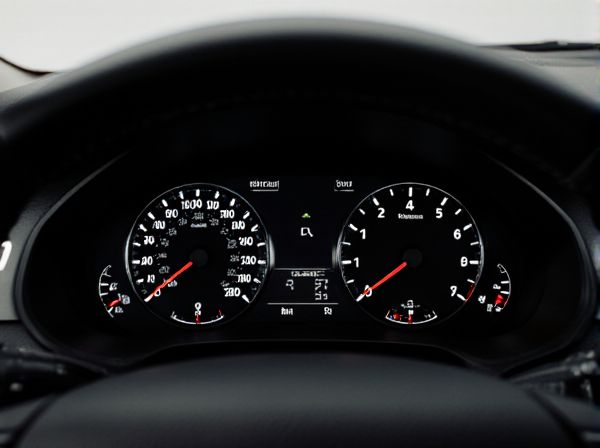
Photo illustration: Analog Gauge vs Digital Gauge
Analog gauges offer a continuous, easy-to-read display with a needle pointing to precise values, making them ideal for quick visual assessments. Digital gauges provide highly accurate, numerical readings that minimize interpretation errors and are often equipped with advanced features like alarms and data logging. Choosing between analog and digital gauges depends on your need for precision, ease of reading, and specific application requirements.
Table of Comparison
| Feature | Analog Gauge | Digital Gauge |
|---|---|---|
| Display Type | Mechanical needle, dial | LCD/LED screen, numeric readout |
| Readability | Quick glance, intuitive | Precise numeric data |
| Accuracy | Moderate, relies on mechanical parts | High, digital sensors and processors |
| Customization | Limited, fixed design | Flexible, programmable layouts |
| Durability | High, fewer electronic failures | Dependent on electronics, may require updates |
| Cost | Generally lower | Higher, advanced technology |
| Power Consumption | Low | Moderate to high |
| Data Types Displayed | Speed, RPM, fuel, temperature | Speed, RPM, fuel, temperature, navigation, alerts |
| Maintenance | Minimal, mechanical calibration | Software updates, potential repairs |
Introduction to Analog and Digital Gauges
Analog gauges display measurements using a dial and pointer, providing real-time visual feedback through mechanical movement, commonly found in automotive dashboards and industrial equipment. Digital gauges use electronic sensors to convert measurements into numerical readings shown on LCD or LED screens, offering higher precision and easier readability. Both types serve critical roles in monitoring parameters such as pressure, temperature, and speed, with analog gauges excelling in simplicity and digital gauges favored for accuracy and data integration.
How Analog Gauges Work
Analog gauges operate using mechanical movement driven by pressure, temperature, or other physical variables that cause a needle to move over a calibrated dial. These gauges typically rely on components such as Bourdon tubes, diaphragms, or capsules that deform under pressure, converting this deformation into rotational motion. The direct mechanical linkage provides real-time, continuous readings without the need for electrical power, making analog gauges reliable and simple for many industrial applications.
How Digital Gauges Work
Digital gauges operate by converting physical measurements into electronic signals through sensors such as strain gauges, thermocouples, or piezoelectric devices. These signals are processed by microprocessors and displayed as numeric values on an LCD or LED screen, offering precise and real-time data. Unlike analog gauges, digital gauges provide enhanced accuracy, data logging capabilities, and easy integration with computer systems for analysis and monitoring.
Key Differences Between Analog and Digital Gauges
Analog gauges display measurements through a moving pointer over a calibrated dial, providing continuous and immediate visual feedback ideal for rapid trend observation. Digital gauges present precise numerical readings with high accuracy and often include features like data logging, multiple unit options, and backlit displays for enhanced visibility. Key differences center on readability, precision, response time, and additional functionalities, with analog gauges excelling in intuitive trend visualization and digital gauges offering superior exactness and versatility in data management.
Accuracy and Precision Comparison
Analog gauges provide real-time readings with continuous scale indicators, offering high precision in detecting small fluctuations but often lack the exact numerical accuracy of digital gauges. Digital gauges display measurements with numeric values, delivering superior accuracy due to advanced sensor technology and reduced human reading error, making them ideal for precise data collection. While analog gauges excel in visual trend analysis and quick estimation, digital gauges dominate in exact measurement and repeatability, crucial for applications requiring stringent accuracy standards.
Ease of Use and Readability
Analog gauges offer quick, intuitive readings through needle position, making them ideal for rapid assessments in dynamic environments. Digital gauges provide precise numerical values, enhancing accuracy and minimizing interpretation errors, especially in low-light or visually complex settings. Ease of use favors analog gauges for experienced users, while digital displays improve readability for those requiring exact measurements.
Durability and Maintenance
Analog gauges typically offer greater durability due to their simpler mechanical components, making them less prone to failure in harsh environments. Digital gauges, while providing precise readings and advanced features, often require more frequent maintenance because of their electronic circuitry and sensitivity to moisture and dust. Maintenance for analog gauges usually involves occasional calibration and mechanical checks, whereas digital gauges need regular software updates and component inspections to ensure accuracy and longevity.
Application Areas for Each Gauge Type
Analog gauges excel in environments requiring quick visual recognition and continuous monitoring, such as automotive dashboards, industrial machinery, and HVAC systems, where real-time needle movement provides intuitive feedback. Digital gauges find extensive use in applications demanding high precision and data logging capabilities, including laboratory instrumentation, medical devices, and aviation systems, benefiting from their ability to display exact numerical values and interface with computerized controls. Selecting between analog and digital gauges depends on the necessity for visual trend analysis versus precise quantification and integration with modern digital infrastructure.
Cost Considerations
Analog gauges typically have lower upfront costs due to simpler design and manufacturing processes, making them budget-friendly for basic measurement needs. Digital gauges often involve higher initial investment because of advanced electronics and display technology, but they offer better accuracy and additional features that can reduce long-term operational expenses. Choosing between analog and digital gauges depends on balancing immediate budget constraints against potential savings from enhanced functionality and precision.
Choosing the Right Gauge for Your Needs
Selecting the right gauge depends on your specific application requirements and accuracy needs. Analog gauges offer intuitive visual feedback, ideal for quick readings and environments without digital infrastructure, while digital gauges provide precise measurements with enhanced features like data logging and remote monitoring. Consider factors such as resolution, ease of use, environmental conditions, and maintenance before deciding between analog and digital gauge options.
 caratoz.com
caratoz.com